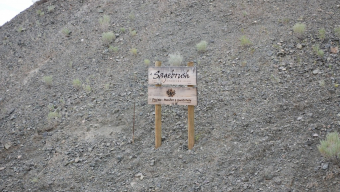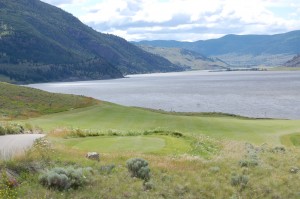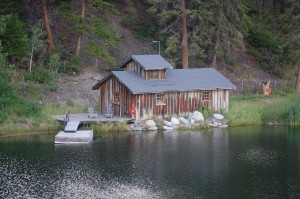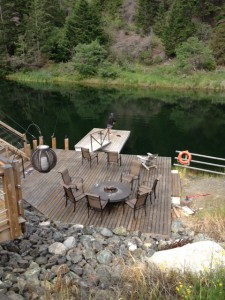QUILCHENA, B.C. – No matter how accurate your GPS or your maps are, it’s still fairly difficult to find Sagebrush Golf & Sporting Club.
That’s just the way they like it here. It’s the definition of a hidden gem.
Sagebrush is a unique golf – and fly fishing – facility about three hours northeast of Vancouver, British Columbia. It sits on a hillside above picturesque Nicola Lake. One tiny sign points (above) to one narrow road that leads you a winding road up to a gated entrance. Miss that sign and you might need to ask a cow or a coyote how to get back.
They prefer that kind of privacy at Sagebrush for it caters to an elite clientele, although, for the foreseeable future, anyone can show up and play the course once you’ve made the proper arrangements. At this point, Sagebrush membership is around 60. It will be capped at 125. Until then, the regular golfer, or as the course membership calls them ‘outlaws, are welcome to experience this quality golfing opportunity.
It’s a course that cuts across hillsides in a Scottish-style links layout, bordered everywhere by wide wispy fescue fields. The fairways are wide and the greens are wider, the biggest in Canada. There are designated tee areas but no tee blocks and no rakes in the bunkers. The blue tee complex plays to 6,640 yards and the whites are 5,487 yards. Nothing in between.
There’s a pond on the back nine in which no-hurry golfers and anglers alike can whip around flies seeking hungry trout and downing Kokanees at the chicy and comfortable Hideout.
You can work up a betting group at the two-acre ‘Badlands” putting course adjacent to the first tee. There are even lights next to each hole and a bar 30 yards away to keep the bets going long after the sun and your balance have departed.
It’s also located in the middle of cattle country and, in fact, herds of cattle are annually guided carefully through fences between the 12th and 13th holes to better pastures without even the need for fixing a hoof mark.
Did we say unique?
“It harkens back to traditions of the game,” said Don Harvey, Sagebrush’s general manager.
That might be true but there aren’t many photos of Old Tom Morris lugging rainbow trout around St. Andrews.
A man-made, four-acre lake just below the 13th tee is what separates this course from virtually any other links-style course in Scotland, Ireland or North America. How many courses encourage you to sit a spell, have a drink, let the next group past through and give you a line to drop?
Actually, you can start, stop and re-start without much worry or delay as there likely won’t be many groups behind you. The daily target for golfers is about 60. Forty is optimum. About 5,000 rounds a year might be too many.
The course was designed Rod Whitman and former PGA pro Dick Zok0l and opened in 2009. Their philosophy was ‘minimalist,’ meaning they wanted to move as little dirt as possible while using the natural terrain and contours to shape each hole.
Consequently, you have to think about every shot, not just the direction you want the ball to travel but where you want it to end up. The nuances of the terrain can take a ball from one side of the fairway to the other and from the front of the green all the way over the back.
“It’s a very playable course,” Harvey said. “It’s not designed for the scratch golfer.”
There are various colored tee complexes marked in black, blue, white and red but no blocks. You can tee it up anywhere on the flat. The idea behind it is the golfer with the honors can pick the line he/she wants to take it toward the hole. All the others in the group must then tee up within a couple club lengths from that spot.
If you should happen to land in a bunker there are no rakes to smooth the sand. You just kind of level it out with your foot. Another old-style tradition.
“The average green size is about 10,000-square feet,” Harvey said. “Typically, greens are around 4000 to 5000 square feet. No. 7 I think is the second largest in Canada at 22,000 square feet. We say second largest because No. 16 is even bigger, 23,000 square feet.”
The playing style is firm and fast, much like we saw at Muirfield during the Open Championship. Yet keeping it on those massive greens can be difficult because it’s difficult to check up. The best play on most holes is to take a seven iron and bump-and-run the ball up, using the contours to take it to the hole.
While the fairways are fescue, the greens are bent greens. That provides a little better roll and familiarity.
So many signature holes on this course because each one is unique in itself. Picking a favorite, it would be No. 16, a par-5, 608-yard hole from the blues. You have a half-blind tee shot because of a slanting hill. You need to take your drive about three-quarters up and over that hill to land it on an ample fairway that tills down toward the hole in the valley.
If you get a good roll, you can end up peering over a slope to the green, around 225 yards below. Even the shorter hitters can get enough roll to make an attempt at reaching in two. It’s a huge green – the 23,000-square foot one – and if you can clear some brush at the bottom of the hill with your second shot. a slope can bounce you onto the green. Two crisp shots and you feel like you’re a big hitter.
The pin placement will depend on whether you’re putting for a legit eagle or lagging, hoping for a two putt. Great design; a blast to play.
For those interested to taking on this course – before it’s slips behind the private wall forever – it costs about $300 per person but that includes food, cart and all-day play. There are one- and two-day packages for foursomes.
You also can stay nearby at the nearby historic turn-of-the-century Quilchena Hotel, established in 1908. The 15-room hotel is a kick for anyone who has ever watched a cowboy movie. The rustic bar still has bullet holes through the wood from an agitated cowboy.
The hotel is just a mile from the course, provided you can find it.
























